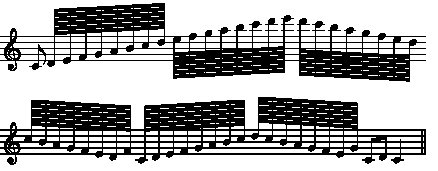#C4
.N,<1NOPQH<K

1.1. The notes of one octave of the scale of C are given in Table 1. It will be seen that the simplest form of note is the eighth note (quaver), dot 6 being added to form the quarter note (crotchet), dot 3 the half note (minim), and dots 3-6 the whole note (semibreve). It will also be noted that each sign represents two different values, but the number of notes in a measure will usually be a sufficient guide to the reader in determining to which of the two values any note belongs. Where confusion is likely to arise (e.g. in the case of the half followed immediately by a 32nd), one of the value signs must be placed between them.
Example 1.1-1#C4
.N,<1NOPQH<K

1.2. When a piece begins with an incomplete measure and there is any doubt as to the value of the first note or rest, the sign ,<1 is used if the note or rest belongs to the smaller of the two values.
Example 1.2-1.#D4
,<1_( "DXJXDXEX FXGXO<K

1.3. With regard to the two signs given for the double whole, the first can be used unless confusion is likely to arise with the signs for the 5th finger, open string, or natural harmonic, in which case it must be replaced by the second.
1.4. Dotted notes are shown by adding dot 3 after the note, according to the number of dots given in the print.
Example 1.4-1
The dotted double whole is shown thus:
(a) yk'
(b) y~cy'
1.4.1. No other sign may come between the note and the dot.
1.5. When music is written in proportional notation, the following scale of values is adopted:
Example 1.5-1.
Longa nopqrst
Brevis ?:$]\[W
Semibrevis defghij
1.6. In cadenzas or passages of unmeasured music where it is often difficult to distinguish between the larger and smaller note-values, the value signs must be used.
Example 1.6-1. (eighths).
#D<#C4
>/L"G+-,55^<1*^IJDEFGH*IJDEFGH"
*"IJDEFGH,5*I "J<K

Example 1.6-2. (128ths and 64ths).
#D<#C4
>/L;&-.!-XV,<1X^JIHIJD*E"
_FGHIJD*EF_11']HIJD*EFGHIH<K

Example 1.6-3. (256ths, 128ths, and eighths).
^<1"D;<1ZFGHIJDE&GHIJDEF"
;ZDJIHGFEYJIHGFEG"
,<1"DEFGHIJDEDJIHGFH^<1DE?<K

1.7. (11-97) Modern notation sometimes includes note-heads of unusual shape indicating either time span or special effects. In braille the shapes are indicated as shown in Table 1. When no specific note value is shown, the value of an eighth-note is used. Note-heads only have no stems and are filled in (like quarters and smaller values). Notes of indeterminate or approximate pitch usually are stem signs without note-heads. For an example of approximate pitch at the end of a slanting line, see Example 23.25.3-1.
1.7.1. The signs for the unusual note shapes may be doubled by repeating the second half of the sign.
(11-97) The print instruction for the organ music excerpt below states that an open note head equals longer duration and a filled-in note head equals shorter duration. Because an open note-head and a whole note are identical in print, they are identical in braille.
Example 1.7.1-1.
>mp"Z5A%G*=5AF<&Y<Z%=<K
